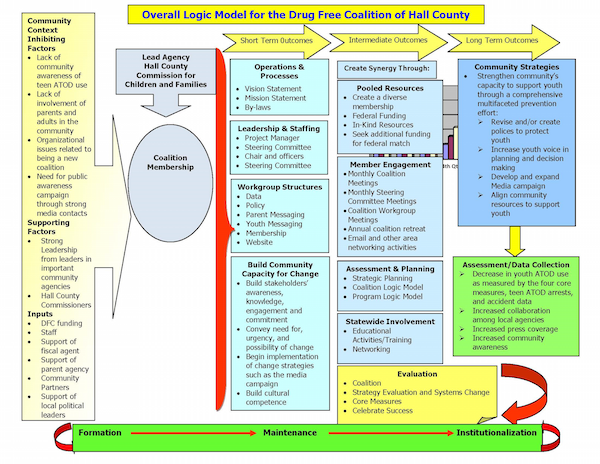My name is Ann Price and I am the President of Community Evaluation Solutions, Inc.(CES), a consulting firm based just outside Atlanta, Georgia. I am a community psychologist and work to infuse environmental approaches into my work developing and evaluating community prevention programs. Much of my work involves working with community coalitions.
Hot Tip: Appreciate how long it takes for community coalitions to mature. Often, community members want to jump in and get right to work. However, the first thing community coalitions need to do is develop structures and processes that will help ensure their long-term success. It may be helpful for you to work with your coalition to develop a logic model that details what steps the coalition needs to take in order to be successful. Here is one example from our work with the Drug-free coalition of Hall County, based on a model by Fran Butterfoss and Michelle Kegler’s Community Coalition Action Theory (2002). Having this Logic Model helped coalition members focus on establishing a good foundation and to recognize the importance of planning and evaluation.
Rad Resource: Fran Butterfoss’s book, Coalitions and Partnerships in Community Health (2007), is a great reference book for coalition leaders, researchers and evaluators. It includes surveys that coalition leaders can use to assess the health of their coalition.
Rad Resource: Fran Butterfoss has a new book, Ignite! Getting Your Community Fired Up for Change, an excellent and accessible resource for coalition leaders and members filled with tips to inspire coalitions to action.
Hot Tip: Community Anti-Drug Coalitions of America (CADCA) is another good resource for both coalitions and evaluators. They host The National Leadership Forum each December in Washington, D.C. and the Mid-year Training Institute held at various locations around the country. Both meetings include one-to one coaching for coalition leaders and a separate tract for youth, the National Youth Leadership Initiative.
Lesson Learned: “Evaluation as intervention” is a concept I have been pondering lately. When you find your coalition is stuck in a “meet and talk” rut, think about redesigning the evaluation to focus on the environmental change strategies the coalition has implemented and the community reach of each strategy. Work on documenting the link between their chosen strategies and community outcomes. Then, use evaluation data to provide more timely feedback to the coalition. This would be a great opportunity to involve coalition members in discussions about where they are, where they would like to be and how, working together, they can get there.
The American Evaluation Association is celebrating CP TIG Week with our colleagues in the Community Psychology Topical Interest Group. The contributions all week come from CP TIG members. Do you have questions, concerns, kudos, or content to extend this aea365 contribution? Please add them in the comments section for this post on the aea365 webpage so that we may enrich our community of practice. Would you like to submit an aea365 Tip? Please send a note of interest to aea365@eval.org. aea365 is sponsored by the American Evaluation Association and provides a Tip-a-Day by and for evaluators.

